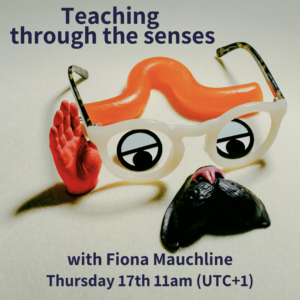Fiona Mauchline joined us for a fabulous session to get learners using different senses in the class. Fiona is an ELT superpower: teacher, materials writer, teacher trainer, #SIGTweetMeet host on Twitter, EVE co-founder and much more. You’ll also spot in Fiona’s session that there were a few images taken from ELTpics, which she co-curated. We started off with a chat about networking online during the pandemic and a return to face-to-face conferences.
Around the ten-minute mark we stopped nattering and moved onto Fiona’s topic (!) and she talked abut the importance of memories and how our senses can be suddenly triggered – in fact, we can even trigger these sensory memories without needing to experience the actual sense.
These are examples of episodic memory, one of the three types of memory we have. Declarative memory – the memory of facts; procedural – the memory of how you do things which becomes second-nature (like muscle memory); and episodic memory which we use the least in the classroom. This is the memory of events which calls on all the different senses. If we were to use it as much as we use declarative and procedural memory in lessons, it would make the language learning process much more memorable for our learners.
Around the twenty-minute mark, Fiona went on to talk about the areas of the brain used in language learning and how they’re connected: the caudate nucleus, amygdala and hippocampus. It’s really interesting to think that grammar and lexis are ‘stored’ in different areas of the brain and that depending on when these different areas develop, learners are more or less effective in remembering concepts.
Neurologically speaking, we have six senses: sight, sound, smell, taste, touch and proprioception – the sense of place and movement. This is the sense which enables you to walk around the house at night in the dark, or to touch your nose with your eyes closed.
Fiona shared an activity then called the Improv Box – you put your hand into a position and your brain decide what you’re holding (as opposed to imagining you’re holding an apple and moving your hand into that position). It’s a great activity which works as well on Zoom as in a face-to-face classroom.
Another activity is a memory map in which you give learners a blank map to fill with vocabulary. Then one learner closes their eyes and their partner leads them around their map giving a tour, “On the right there’s a courgette and if you continue walking, you’ll see a sandwich at the end of the street.” After leading them through the map, the learner who had their eyes closed retraces the route, giving the direactions.
Next up was an idea to use your inner nose. Before the lesson, think of three things which trigger olfactory memory for you. During the lesson, have learners close their eyes and introduce the first ‘smell’ and have learners write down some words they associate with it, such as an adjective, an object, a place and so on. Fiona’s three typical starting points for this activity are coffee, freshly-cut grass and swimming pool. Give learners time to compare their words and then put them all on the board in feedback – you can then use this as a starting point for a creative writing activity. For example, you could have learners imagine they’re in one of the places which came out of the wordpool.
For touch, you can use the old classic of taking an unknown object into the class – such as a spurtle – and have learners speculate about what it is and what it’s used for. You can also use pairs of items and have learners compare them. For example, it could be two stones – and learners don’t even need to feel them themselves to imagine what the differences between them might be.
To trigger sound, you can use visualisations using your voice or music. I absolutely love visualisations because they’re so easy to incorporate into the lesson and are great for emergent language and personalisation. Fiona highlighted that this is a great opportunity to bring L1 into the classroom as well, as translation triggers the caudate nucleus. It’s easy to bring the different senses into the lesson and you can make the visualisation as big as you want and have learners explore a small area or a much larger space.
The next idea would work much better in a dark face-to-face class rather than in the onlne environment as the activity plays on the 3D nature of the elements involved. You start with a single item, such as a lit candle, and have learners make notes about how it makes them feel. Then they close their eyes and you add another element, such as a doll. Again, learners open their eyes and make notes on ow the story they’re imagining is developing. When they close their eyes again, you remove the doll and add another item such as a half-full or half-empty glass. When learners close their eyes the final time, you blow out the candle.
The next idea with sight involves showing three pictures for learners to choose from. It’s good to choose three different images to give learners more choice, and also to choose images which doesn’t have declarative knowledge in it, i.e. if you have three places, choose locations which don’t show exactly where they are so learners won’t have background knowledge of the place. You can do the activity as well using just three words, e.g. forest or baby buggy.
